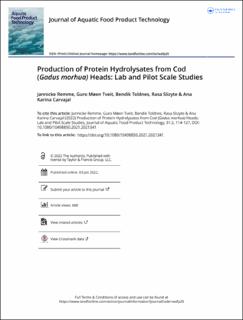| dc.contributor.author | Remme, Jannicke | |
| dc.contributor.author | Tveit, Guro Møen | |
| dc.contributor.author | Toldnes, Bendik | |
| dc.contributor.author | Slizyte, Rasa | |
| dc.contributor.author | Carvajal, Ana Karina | |
| dc.date.accessioned | 2023-06-19T09:04:17Z | |
| dc.date.available | 2023-06-19T09:04:17Z | |
| dc.date.created | 2022-04-29T12:45:46Z | |
| dc.date.issued | 2022 | |
| dc.identifier.citation | Journal of Aquatic Food Product Technology. 2022, 31 (2), 114-127. | en_US |
| dc.identifier.issn | 1049-8850 | |
| dc.identifier.uri | https://hdl.handle.net/11250/3072009 | |
| dc.description.abstract | Cod heads were hydrolysed using different enzymes (Alcalase, Flavourzyme, Papain, Bromelain, and Protamex) at concentration of 0.1% for 1 hour and different water/raw material ratios. The most promising processing conditions were further verified in large-scale trials in a pilot plant. The results showed that the water/raw material ratios had little effect on hydrolysis yield, protein content, or the molecular weight distribution in hydrolysate. However, different enzymes led to differences in chemical composition and molecular weight distribution. Protein recovery was lower in the pilot trial, primarily because pilot and industrial processing equipment must be adapted and optimized to the raw material and process. Upscaling proved that high-quality protein powder can be produced from cod heads. The product has a neutral smell, light color, contains more than 80% protein, and could serve as an excellent source of protein for human consumption. | en_US |
| dc.language.iso | eng | en_US |
| dc.publisher | Taylor & Francis | en_US |
| dc.rights | Navngivelse 4.0 Internasjonal | * |
| dc.rights.uri | http://creativecommons.org/licenses/by/4.0/deed.no | * |
| dc.subject | Enzymatic hydrolysis | en_US |
| dc.subject | Protein Hydrolysate | en_US |
| dc.subject | Cod heads | en_US |
| dc.subject | Rest raw material | en_US |
| dc.subject | Whitefish | en_US |
| dc.title | Production of Protein Hydrolysates from Cod (Gadus morhua) Heads: Lab and Pilot Scale Studies | en_US |
| dc.title.alternative | Production of Protein Hydrolysates from Cod (Gadus morhua) Heads: Lab and Pilot Scale Studies | en_US |
| dc.type | Journal article | en_US |
| dc.type | Peer reviewed | en_US |
| dc.description.version | publishedVersion | en_US |
| dc.rights.holder | © 2022 The Author(s). Published with license by Taylor & Francis Group, LLC. This is an Open Access article distributed under the terms of the Creative Commons Attribution License (http://creativecommons.org/licenses/by/4.0/), which permits unrestricted use, distribution, and reproduction in any medium, provided the original work is properly cited | en_US |
| dc.source.pagenumber | 114-127 | en_US |
| dc.source.volume | 31 | en_US |
| dc.source.journal | Journal of Aquatic Food Product Technology | en_US |
| dc.source.issue | 2 | en_US |
| dc.identifier.doi | 10.1080/10498850.2021.2021341 | |
| dc.identifier.cristin | 2020117 | |
| dc.relation.project | Norges forskningsråd: 294539 | en_US |
| cristin.ispublished | true | |
| cristin.fulltext | original | |
| cristin.qualitycode | 1 | |

